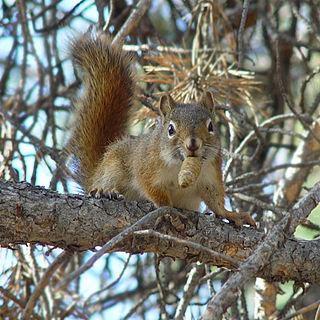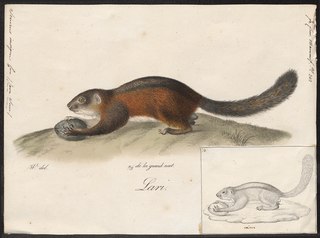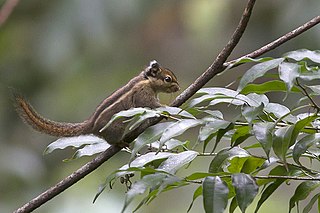
Chipmunks are small, striped rodents of Sciuridae, the squirrel family; specifically, they are ground squirrels (Marmotini). Chipmunks are found in North America, with the exception of the Siberian chipmunk which is found primarily in Asia.

Squirrels are members of the family Sciuridae, a family that includes small or medium-sized rodents. The squirrel family includes tree squirrels, ground squirrels, and flying squirrels. Squirrels are indigenous to the Americas, Eurasia, and Africa, and were introduced by humans to Australia. The earliest known fossilized squirrels date from the Eocene epoch, and among other living rodent families, the squirrels are most closely related to the mountain beaver and dormice.

Pine squirrels are squirrels of the genus Tamiasciurus, in the Sciurini tribe, of the large family Sciuridae.

The South Western Ghats montane rain forests is an ecoregion in South India, covering the southern portion of the Western Ghats in Karnataka, Kerala and Tamil Nadu at elevations from 1,000 to 2,695 m. Annual rainfall in this ecoregion exceeds 2,800 mm (110 in).

The South Western Ghats moist deciduous forests is an ecoregion in the Western Ghats of southern India with tropical and subtropical moist broadleaf forests. This biome covers the Nilgiri Hills between elevation of 250 and 1,000 m in Kerala, Karnataka and Tamil Nadu states.

The genus Sciurus contains most of the common, bushy-tailed squirrels in North America, Europe, temperate Asia, Central America and South America.

Asiatic striped squirrels are a genus (Tamiops) of squirrels (Sciuridae) in the subfamily Callosciurinae. They are small striped arboreal squirrels from Asia. Their head to body length measured from 10 to 13 cm. They often are confused with other squirrels. In contrast to these other squirrels, they have smaller rounded ears with white-tipped hairs. A black longitudinal stripe is present in the middle of the back, which is parallel on both sides with two pairs of pale longitudinal stripes. These pale stripes are separated by dark brownish stripes. In some countries, they are kept as pets.

Lariscus is a genus of squirrels in the subfamily Callosciurinae. They are only found in Southeast Asia. Species in this genus include:

Layard's palm squirrel or flame-striped jungle squirrel is a species of rodent in the family Sciuridae endemic to Sri Lanka. The validity of the subspecies F. l. dravidianus based on a single specimen from the southern tip of India has been questioned, and is probably a juvenile F. sublineatus. Known as මූකලන් ලේනා in Sinhala.

The Indian palm squirrel or three-striped palm squirrel is a species of rodent in the family Sciuridae found naturally in India and Sri Lanka. In the late 19th century, the palm squirrel was introduced to Madagascar, Réunion, Mayotte, Comoro Islands, Mauritius, and Seychelles. The closely related five-striped palm squirrel, F. pennantii, is found in northern India, and its range partly overlaps with this species.

The northern palm squirrel, also called the five-striped palm squirrel, is a species of rodent in the family Sciuridae. Some authorities recognize two subspecies, F. p. pennantii and F. p. argentescens. It is a semi-arboreal species found in tropical and subtropical dry deciduous forests and many other rural and urban habitats. It is a common species with a wide range and the International Union for Conservation of Nature has rated its conservation status as being of "least concern".

The Nilgiri striped squirrel is a threatened species of rodent, a small squirrel (Sciuridae) from rainforests in the southern Western Ghats, including the Nilgiris, in Peninsular India. It formerly included Funambulus obscurus from Sri Lanka as a subspecies, at which point the English name of the "combined species" also was dusky striped squirrel.

The jungle palm squirrel, jungle striped squirrel, or Western Ghats squirrel is a species of rodent in the family Sciuridae which is endemic to India.

Petaurista is a genus of rodent in the family Sciuridae. They are large to very large flying squirrels found in forests and other wooded habitats in southern and eastern Asia.

The Himalayan striped squirrel, also known as western striped squirrel or Burmese striped squirrel, is a species of rodent in the family Sciuridae. It lives in a variety of forest from tropical to subtropical in Bhutan, Cambodia, China, India, Laos, Malaysia, Myanmar, Nepal, Thailand, and Vietnam. This species is diurnal, arboreal and feeds on fruit, vegetable matter, and insects. It often seen in small groups and uses tree holes for shelter.

The Callosciurinae are an Asiatic subfamily of squirrels containing over 60 species named after the genus Callosciurus, which means "beautiful squirrels".

The dusky striped squirrel is a species of small squirrel from Sri Lanka that is largely confined to rainforests in the southwestern "wet zone" with higher rainfall than the rest of the island. It was formerly regarded as a subspecies of Funambulus sublineatus from India, at which point the English name of the "combined species" also was dusky striped squirrel. It is known as පුංචි ලේනා or "batu lena" in the Sinhala language.
Dusky palm squirrel is a common name applied to two rodents that were formerly considered to be a single species.

















